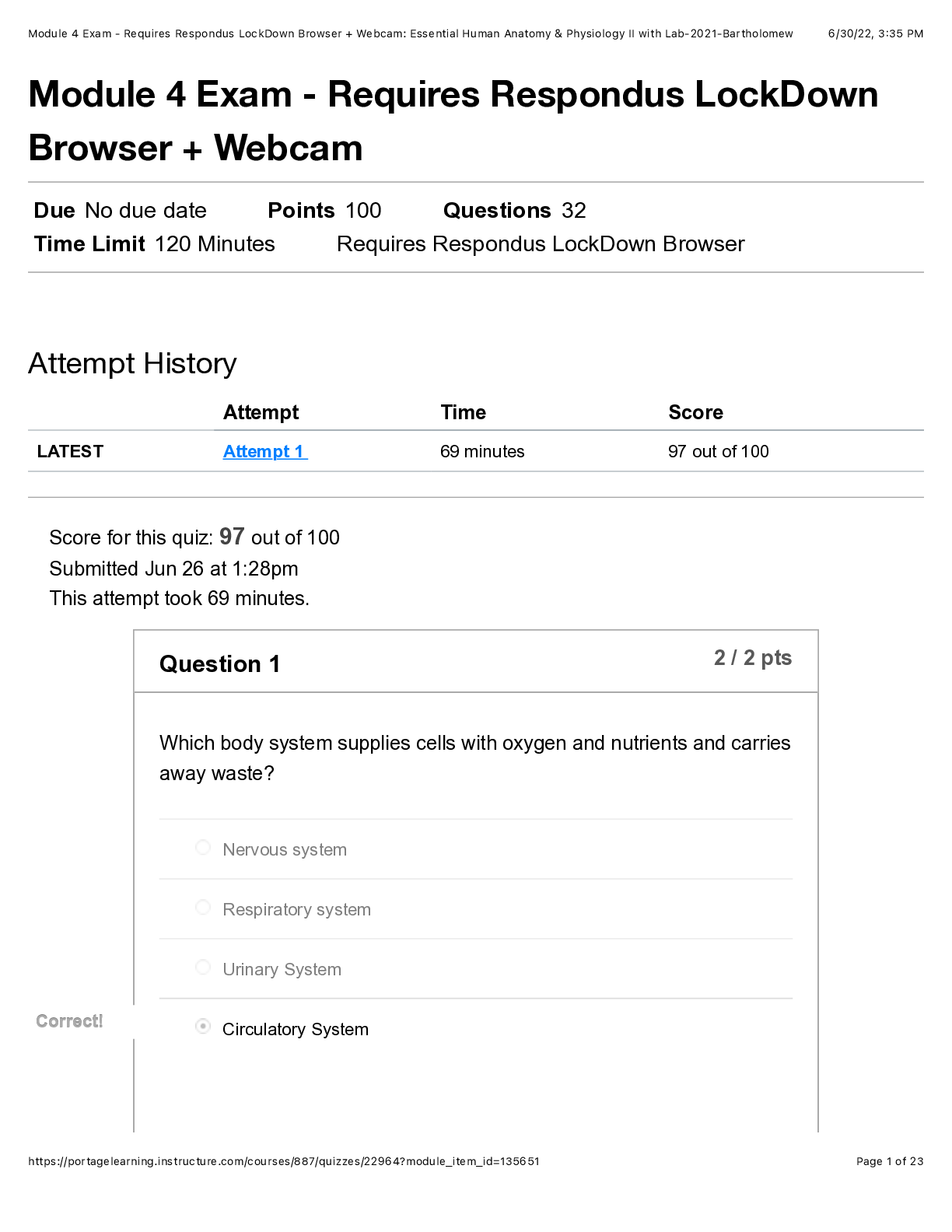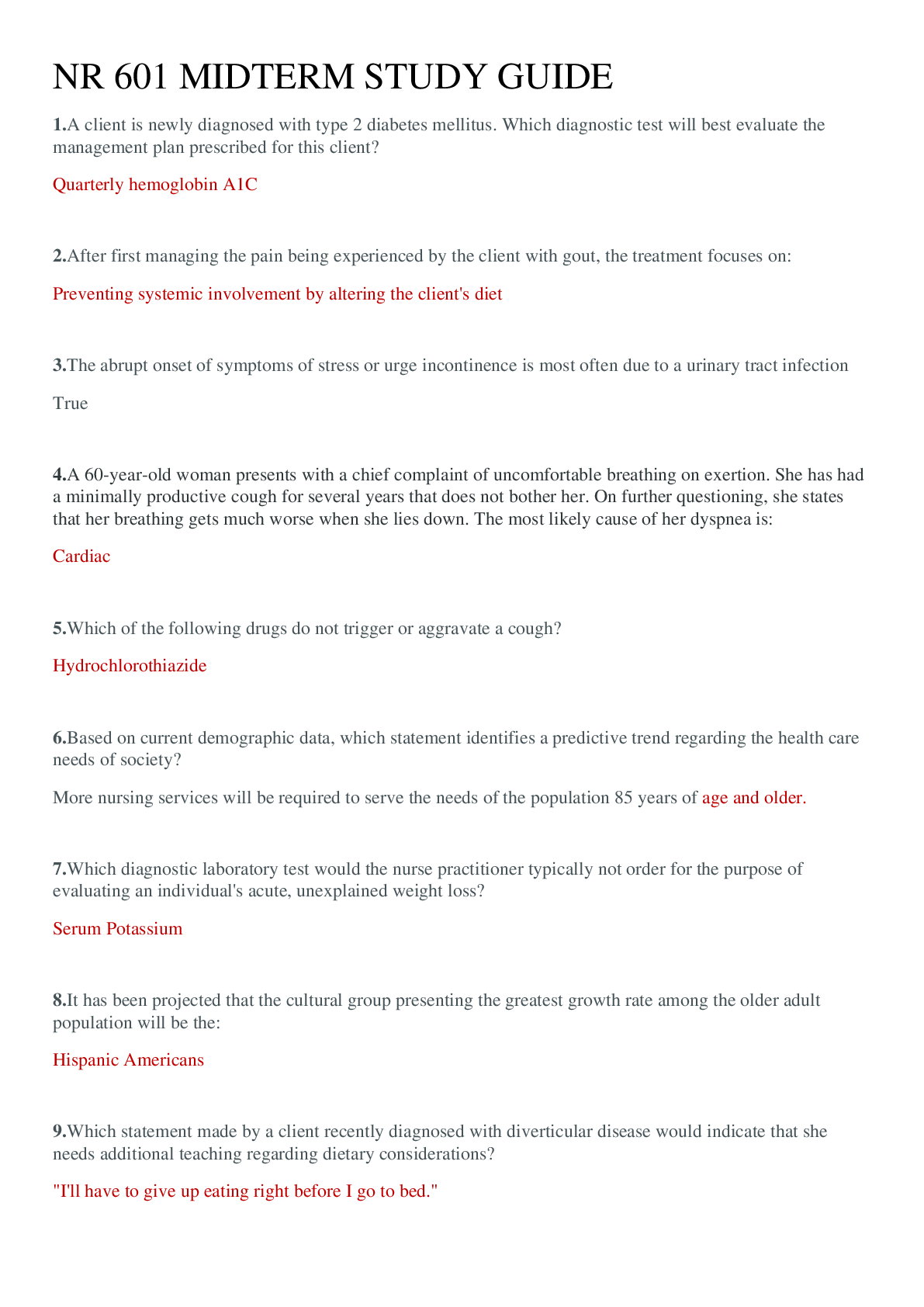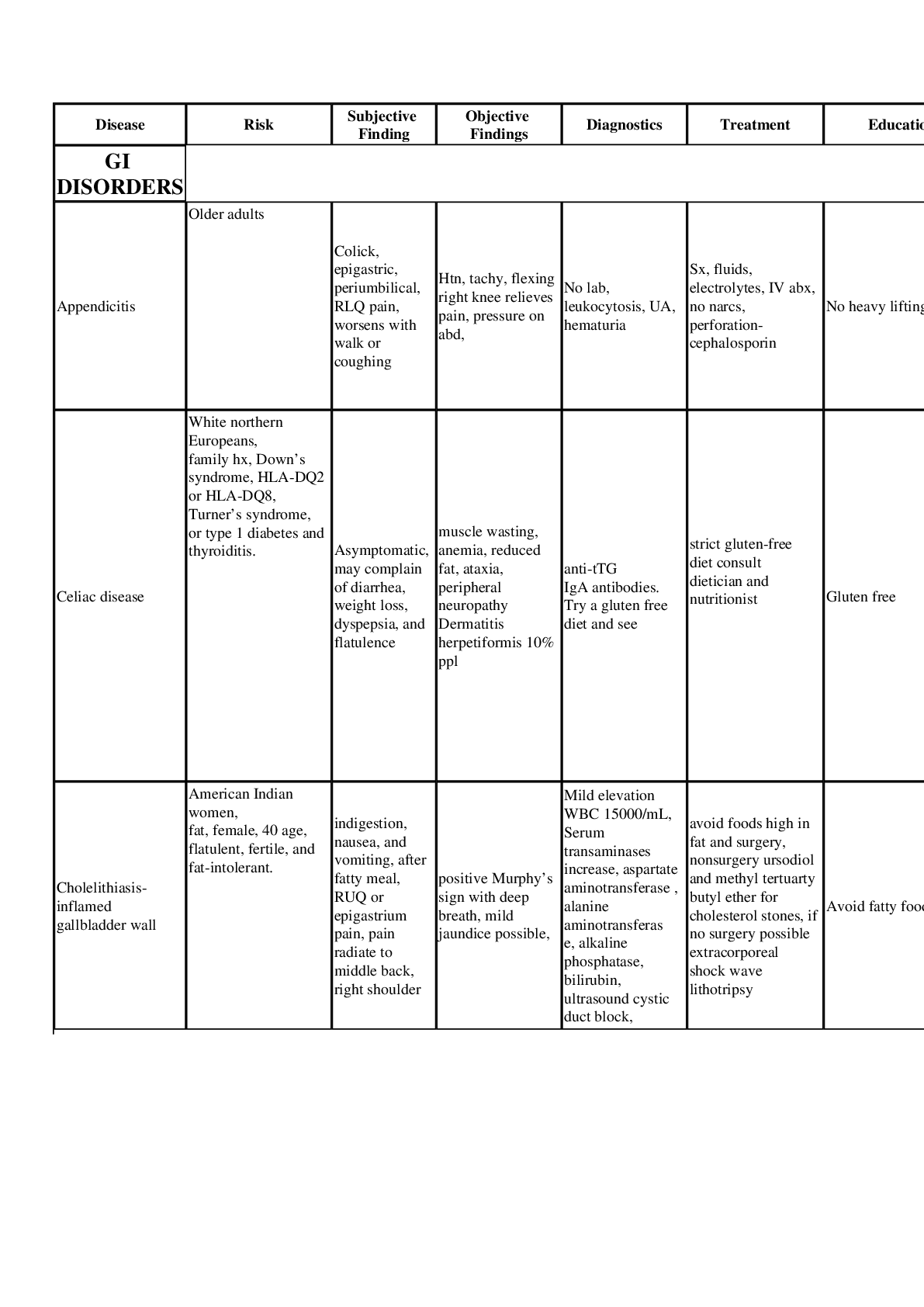*NURSING > QUESTIONS & ANSWERS > NR 511|NR511 Midterm Exam Study Guide;Updated (2020) Complete A+ guide. (All)
NR 511|NR511 Midterm Exam Study Guide;Updated (2020) Complete A+ guide.
Document Content and Description Below
NR 511 – FINAL EXAM STUDY GUIDE WEEK 1 1. Define diagnostic reasoning Reflective thinking because the process involves questioning one's thinking to determine if all possible avenues have been e... xplored and if the conclusions that are being drawn are based on evidence. Seen as a kind of critical thinking. 2. Discuss and identify subjective data? What the patient tells you, complains of, etc. Chief complaint HPI ROS 3. Discuss and identify objective data? What YOU can see, hear, or feel as part of your exam. Includes lab data, diagnostic test results. Components of HPI 4. Discuss and identify the components of the HPI Specifically related to the chief complaint only. Detailed breakdown of CC. OLDCART 5. What is medical coding? The use of codes to communicate with payers about which procedures were performed and why 6. What is medical billing? Process of submitting and following up on claims made to a payer in order to receive payment for medical services rendered by a healthcare provider. 7. What are CPT codes? Common procedural terminology Offers the official procedural coding rules and guidelines required when reporting medical services and procedures performed by physician and non-physician providers. 8. What are ICD codes? International classification of disease Used to provide payer info on necessity of visit or procedure performed. 9. What is specificity? The ability of the test to correctly detect a specific condition. If a patient has a condition but test is negative, it is a false negative. If a patient does NOT have a condition but the test is positive, it is a false positive. 1 NR 511 – FINAL EXAM STUDY GUIDE 10.What is sensitivity? Test that has few false negatives. Ability of a test to correctly identify a specific condition when it is present. The higher the sensitivity, the lesser the likelihood of a false negative. 11.What is predictive value? The likelihood that the patient actually has the condition and is, in part, dependent upon the prevalence of the condition in the population. If a condition is highly likely, the positive result would be more accurate. 12.Discuss the elements that need to be considered when developing a plan Pt's preferences and actions Research evidence Clinical state/circumstances Clinical expertise 13.Describe the components of Medical Decision Making in E&M coding Risk Data Diagnosis The more time and consideration involved in dealing with a pt, the higher the reimbursement from the payer. Documentation must reflect MDM! evaluation and management (E&M) 14.Correctly order the E&M office visit codes based on complexity from least to most complex New patient: Established patient: 1. Minimal/RN visit: 99201 Minimal RN visit: 99211 2. Problem focused: 99202 Problem focused: 99212 3. Expanded problem focused: 99203 Expanded problem focused: 99213 4. Detailed: 99204 Detailed: 99214 5. Comprehensive: 99205 Comprehensive: 99215 15.Discuss a minimum of three purposes of the written history and physical in relation to the importance of documentation Important reference document that gives concise info about the pt's Hx and exam findings. Outlines a plan for addressing issues that prompted the visit. Info should be presented in a logical fashion that prominently features all data relevant to the pt's condition. Is a means of communicating info to all providers involved in the pt's care. Is a medical-legal document. Is essential in order to accurately code and bill for services. 2 NR 511 – FINAL EXAM STUDY GUIDE 16.Accurately document why every procedure code must have a corresponding diagnosis code Diagnosis code explains the necessity of the procedure code. Insurance won't pay if they don't correspond. 17.Correctly identify a patient as new or established given the historical information If that pt has never been seen in that clinic or by that group of providers OR if the pt has not been seen in the past 3 years. 18.Identify the 3 components required in determining an outpatient, office visit E&M code Place of service Type of service Patient status 19.Describe the components of Medical Decision Making in E&M coding Risk Data Diagnosis The more time and consideration involved in dealing with a pt, the higher the reimbursement from the payer. Documentation must reflect MDM! evaluation and management (E&M) 20.Explain what a “well rounded” clinical experience means Includes seeing kids from birth through young adult visits for well child and acute visits, as well as adults for wellness or acute/routine visits. Seeing a variety of pt's, including 15% of peds and 15% of women's health of total time in the program. 21.State the maximum number of hours that time can be spent “rounding” in a facility No more than 25% of total practicum hours in the program 22.State 9 things that must be documented when inputting data into clinical encounter Date of service Age Gender and ethnicity Visit E&M code CC Procedures Tests performed and ordered Dx 3 NR 511 – FINAL EXAM STUDY GUIDE Level of involvement (mostly student, mostly preceptor, together, etc.) 23.What is the first “S” in the SNAPPS presentation? Summarize: present the pt's H&P findings 24.What is the “N” in the SNAPPS presentation? Narrow: based on the H&P findings, narrow down to the top 2-3 differentials 25.What is the “A” in the SNAPPS presentation? Analyze: analyze the differentials. Compare and contrast H&P findings for each of the differentials and narrow it down to the most likely one 26.What is the first “P” in the SNAPPS presentation? Probe: ask the preceptor questions of anything you are unsure of. 27.What is the second “P” in the SNAPPS presentation? Plan: come up with a specific management plan . 28.What is the last “S” in the SNAPPS presentation? Self-directed learning: an opportunity to investigate more about any topics that you are uncertain of. 4 NR 511 – FINAL EXAM STUDY GUIDE WEEK 2 1. What is the most common type of pathogen responsible for acute gastroenteritis? Viral (can be viral, bacterial, or parasitic), usually norovirus 2. Assessing for prior antibiotic use is a critical part of the history in patients presenting with diarrhea. True 3. Describe the difference between Irritable Bowel Disease (IBS) and Inflammatory Bowel Disorder (IBD) IBS: disorder of bowel function (as opposed to being due to an anatomic abnormality). Changes in bowel habits (diarrhea, constipation, abd pain, bloating, rectal urgency w/diarrhea). Symptoms fall into two categories: abd pain/altered bowel habits, and painless diarrhea. Usually pain is LLQ. PE: normal except for tenderness in colon. Labs: CBC, ESR. Most other labs and radiology/scopes are normal. Dx made on careful H&P. May be associated with non-intestinal (extra-intestinal) symptoms (sexual function difficulty, muscle aches/pains, fatigue, fibromyalgia, HAs, back pain, urinary symptoms). Not associate with serious medical consequences. Not a risk factor for other serious GI dz's. Does not put extra stress on other organs. Overall prognosis is excellent. Major problem: changes quality of life. Treatment: based on symptom pattern. May include diet, education, pharm (for modsevere pt's)/other supportive interventions. Usually focuses on lifestyle, diet, and stress reduction. NO PROVEN TREATMENT! Antidiarrheals: use temporarily, reserve for severe. Loperamide (Imodium) or diphenoxylate (Lomotil) 2.5-5mg q6h usually works. Constipation: high fiber diet, hydration, exercise, bulking agents. If these don't work, intermittent use of stimulant laxatives (lactulose or mag hydroxide); don't use long-term! Linzess (linaclotide), Trulance (plecanatide), and Amitiza (lubiprostone): newer for constipation, work locally on apical membrane of GI tract to increase intestinal fluid secretion and improve fecal transit. Abd pain: dicloclymine (Bentyl), hyoscyamine (avoid anticholinergics in glaucoma and BPH, especially in elderly). TCAs and SSRIs can relieve symptoms in some pt's. Can be managed by PCP, but if not responsive to tx, refer to GI. 5 NR 511 – FINAL EXAM STUDY GUIDE IBD: chronic immunological dz that manifests in intestinal inflammation. UC and Crohn's are most common. UC: mucosal surface of colon is inflamed, resulting in friability, erosions, bleeding. Usually occurs in rectosigmoid area, but can involve entire colon. Ulcers form in eroded tissue, abscesses form in crypts, become necrotic and ulcerate, mucosa thickens/swells, narrowing lumen. Pt's are at risk for perforation. Symptoms: bleeding, cramping, urge to defecate. Stools are watery diarrhea with blood/mucus. Fecal leuks almost always present in active UC. Tenderness usually in LLQ or across entire abd. Crohn's: inflammation extends deeper into intestinal wall. Can involve all or any layer of bowel wall and any portion of GI tract from mouth to anus. Characteristic segmental presentation of dz'd bowel separated by areas of normal mucosa ("skipped lesions"). With progression, fibrosis thickens bowel wall, narrowing lumen, leading to obstructions, fistulas, ulcerations. Pt's are at greater risk for colorectal cancer. Most common symptoms: cramping, fever, anorexia, wt loss, spasms, flatulance, RLQ pain/mass, bloody/mucus/pus stools. Symptoms increase with stress, after meals. 50% of pt's have perianal involvement (anal/perianal fissures). Inflammation can lead to bleeding, fever, increased WBC, diarrhea, cramping. Abnormalities can be seen on cross-sectional imaging or colonscopy. No single explanation for IBD. Theory: viral, bacterial, or allergic process initially inflames small or large intestine, results in antibody development which chronically attack intestine, leading to inflammation. Possible genetic predisposition. Dx made by H&P correlated with symptoms, must exclude infectious cause for colitis. Primary dx tools: sigmoidoscopy, colonoscopy, barium enema w/small bowel followthrough, CT. Tx is very complex, managed by GI. Drugs: 5-aminosalicylic acid agents have been used for >50yrs, but have shown to be of little value in CD; still used as first attempt for UC. Antidiarrheals w/caution (constipation). Don't use in acute UC or if toxic megacolon. Corticosteroids used when 5-ASA not working. If corticosteroids don't work, use immunomodulators (azathioprine, methotrexate, 6-mercaptopurine), but can cause bone marrow suppression and infection. Newer class: anti-TNF (biologic response modifiers) for mod-severe dz. Remicade (infliximab), Humira (adalimumab), Entyvio (vedolizumab); can increase risk of infection. 4. Discuss two common Inflammatory Bowel Diseases UC and Crohn's are most common. 6 NR 511 – FINAL EXAM STUDY GUIDE 5. Discuss the diagnosis of diverticulitis, risk factors, and treatments Subjective: S/S of infection (fever, chills, tachycardia) Localized pain LLQ Anorexia, n/v If fistula present, additional s/s will be present associated w/affected organ (dysuria, pneumaturia, hematachzia, frank rectal bleeding, etc) Objective: Tenderness in LLQ Maybe firm, fixed mass at area of diverticuli Maybe rebound tenderness w/involuntary guarding/rigidity Hypoactive bowel sounds initially, then hyperactive if obstructive process present Rectal tenderness +occult blood Diagnostics: Mild-moderate leukocytosis Possibly decreased hgb/hct r/t rectal bleeding Bladder fistula: urine will have increased WBC/RBC, culture may be + If peritonitis, blood culture should be done (for bacteremia) Abd XR: perforation, peritonitis, ileus, obstruction CT may be needed to confirm 7 NR 511 – FINAL EXAM STUDY GUIDE 6. Identify the significance of Barrett’s esophagus. A condition in which the esophageal lining is replaced by a tissue resembling intestinal lining. Squamous lining of lower esophagus turns into columnar epithelium (goblet cells). Average age of onset: 55 1.6 – 6.8% of persons affected (5-10% of people with GERD get Barrett’s esophagus). Risk Factors: GERD Obesity Smoking Age Gender Ethnicity Signs/Symptoms: 1.Long-term indigestion-heart burn, fullness, bloating, belching 2. difficulty swallowing food 3. losing symptoms of GERD without doing anything Diagnosis: Upper endoscopy & biopsy if cells are present How to tx: Medications (acid suppressing (proton pump inihibitors) Endoscopic ablative therapies Endoscopic mucosal resection Esophagectomy Increases Risk of BE: H. pylori NSAIDS and aspirins Diet and nutrition Decreases Risk of BE: Folate Vitamin E Intake of Lutein 8 NR 511 – FINAL EXAM STUDY GUIDE 7. What is best test for diagnosing GERD? 24 pH probe - Probe through nose, sits in esophagus for 24 hours - Constantly monitors pH Heartburn is typical symptom. Usually occurs 30-60 min after meals and with reclining. Burning chest pain and regurgitation are common. Pain may be relieved by antacids. Most have no structural defects Non-GI symptoms included asthma, chronic cough, laryngitis, sore throat or noncardiac chest pain. 8. Risk factors of GERD: Obesity Pregnancy Smoking Collagen Vascular Disease ETOH use Hiatal Hernia Gender (more common in males) 9 NR 511 – FINAL EXAM STUDY GUIDE 9. How do we treat suspected GERD in patients with classic symptoms? Empiric therapy (PPI trial) is used both as a test and a treatment Empiric therapy: PPI once daily for 4-8 weeks PPI are preferred over H2 receptor antagonists PPI should be taken 30min before breakfast Many PPI's now over OTC formulations 10-20% will need twice daily PPI to get relief Patients with good symptom control on empiric therapy s/b continued on PPI for 8-12 weeks. 1st line: life modification (elevate HOB, smoking cessation, avoid high fat/large meals, chocolate, ETOH, peppermint, caffeine, onions, garlic, citrus, tomatoes); don't sleep 3- 4hrs after meal, avoid bedtime snack. Meds: avoid Ca blockers, beta blockers, alpha adrenerg [Show More]
Last updated: 2 years ago
Preview 1 out of 49 pages

Buy this document to get the full access instantly
Instant Download Access after purchase
Buy NowInstant download
We Accept:

Reviews( 0 )
$8.00
Can't find what you want? Try our AI powered Search
Document information
Connected school, study & course
About the document
Uploaded On
Oct 09, 2022
Number of pages
49
Written in
Additional information
This document has been written for:
Uploaded
Oct 09, 2022
Downloads
0
Views
92



 (1).png)
.png)








, 100% Correct, Download to Score A.png)





 LATEST VERIFIED GUIDE FOR EXAM PREPARATION, Graded A.png)
Download to Score A.png)



